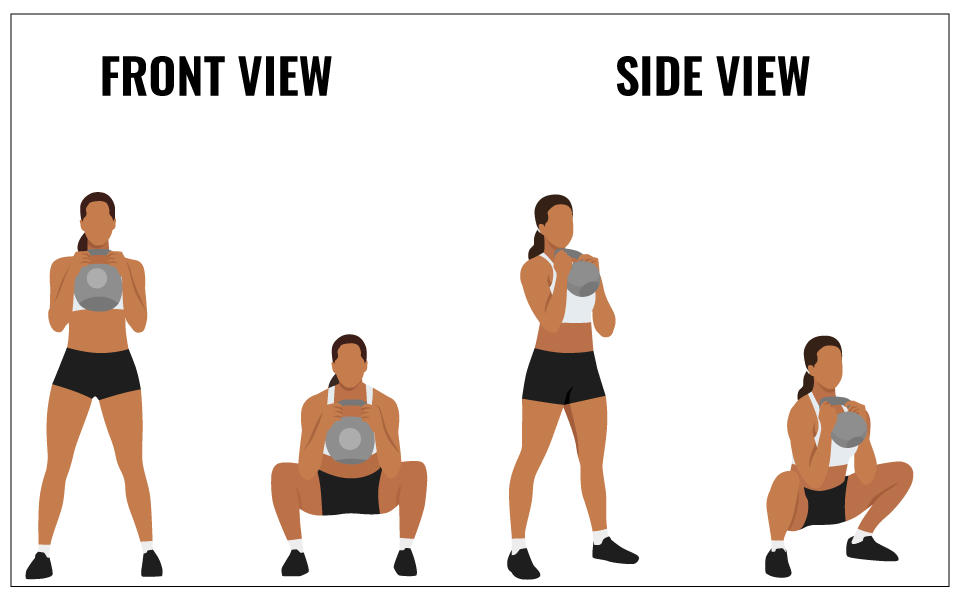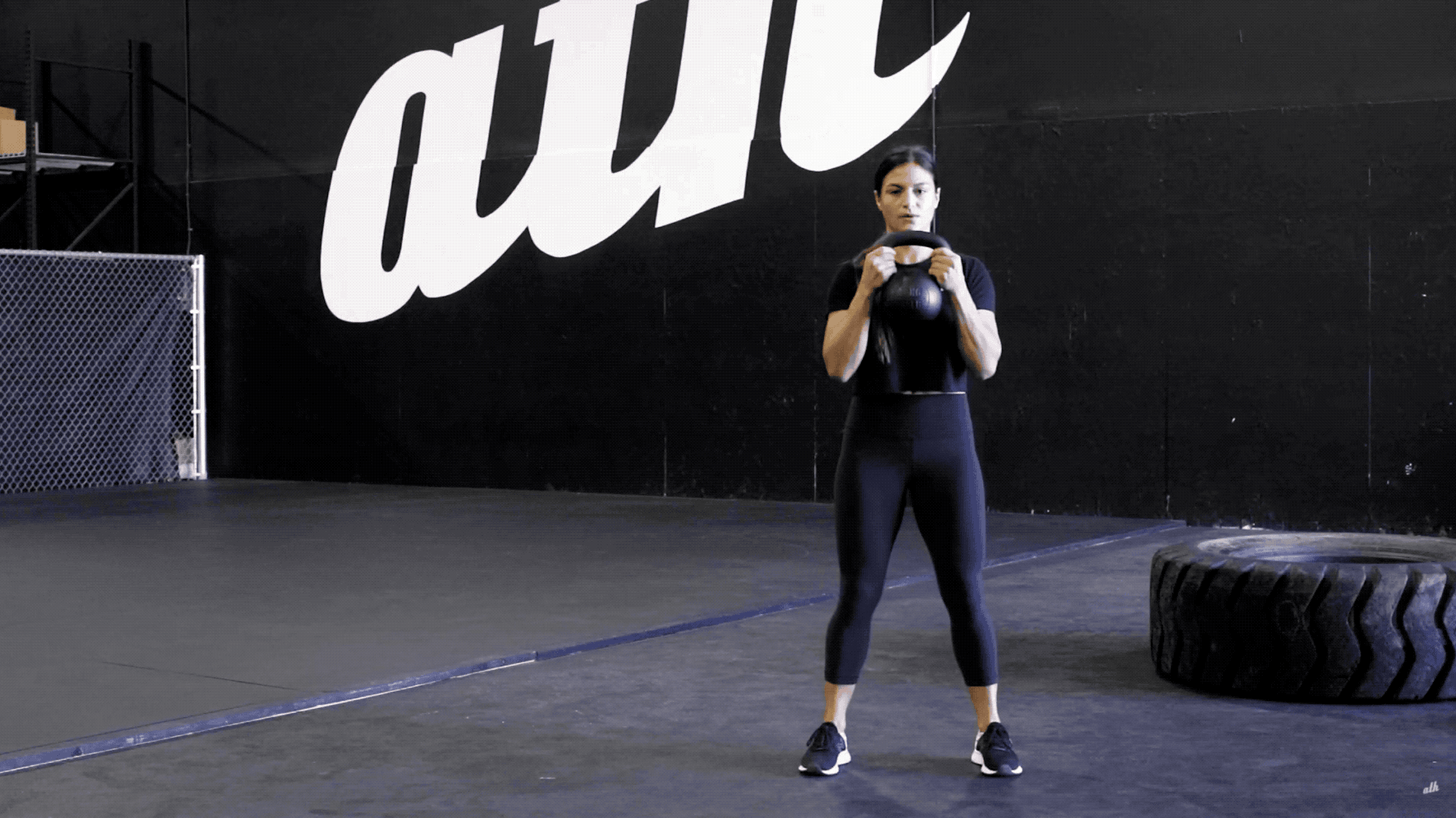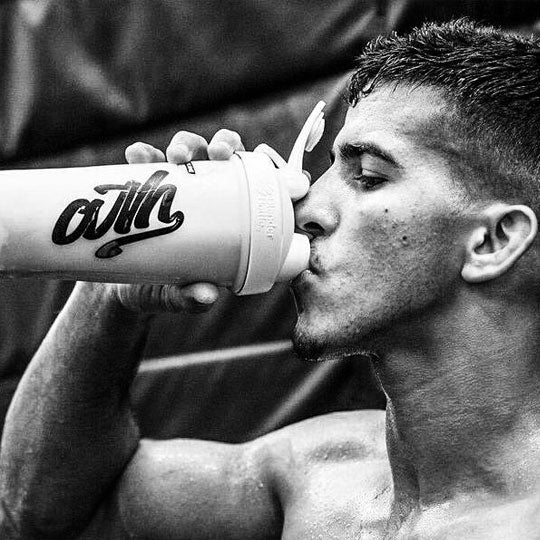How to Use Kettlebell Goblet Squats to Build Stronger Legs

Kettlebell goblet squats are a foundational movement that can be used to build strength, increase mobility, and improve cardio - it all depends on your set reps and training.
Kettlebell Rep Ranges
- Strength
- Hypertrophy
- Endurance
STRENGTH
1-6 Reps
If you're using the goblet squat to build strength, use a heavy kettlebell and bang out 1-6 reps. Get your form down to avoid injury, and squeeze those glutes at the top to improve glute strength.
Try the standard 5x5 routine to build strength.
HYPERTROPHY
8-12 Reps
Hypertrophy, otherwise known as muscle development, requires more time under tension, hence the higher reps when compared to strength training.
Shoot for 8-12 reps, 3-5 sets.
ENDURANCE
15-20 Reps
Rep ranges 15 and above are used to improve cardiovascular fitness and endurance.
More reps improve endurance and fire up your muscles, literally. You'll feel the burn.
Shoot for 15-20 reps of goblet squats before switching to a different exercise.
WHAT IS A KETTLEBELL GOBLET SQUAT?
The Kettlebell Goblet Squat is one of the most effective exercises for building full lower body strength, including the quadriceps, hamstrings, glutes, and calves.
When performed correctly, this squat is easy on the back, making it a great exercise for beginners and advanced strength trainers.
It's called the Goblet Squat because you hold the weight in front of your body like a goblet. A goblet squat differs from a traditional squat due to the weight additions. In a goblet squat, you hold a dumbbell or kettlebell at your chest.
KETTLEBELL GOBLET SQUAT VS. BARBELL FRONT SQUAT
The barbell front squat is similar to a kettlebell goblet squat. The movements and where the weight is held are almost identical. Performing a barbell front squat safely and effectively requires wrist and shoulder mobility.
The kettlebell goblet squat is a simpler variation used to advance to the front squat. Goblet squats are best performed at a slow-to-moderate tempo with high repetitions to build strong muscle. Barbell front squats are best for developing maximum strength.
You can use more weight when performing the barbell front squat, which is a plus for some individuals. It can, however, result in injury due to its technical nature.
Although the goblet squat and front squat are closely related exercises, they differ in several ways that you should know if you want to get the most out of your workout.
| KETTLEBELL GOBLET SQUAT | BARBELL FRONT SQUAT | |
| EQUIPMENT | Kettlebell | Barbell, Plates, and Squat Rack |
| MOBILITY | Requires mobility in the hips, knees, and ankles. | Requires mobility in the hips, knees, ankles, and wrists. |
| MUSCLES WORKED |
Quads, Hamstings, Core, Glutes, & Scapular Stabilizers. |
Quads, Glutes, Hips, Hamstrings, & Upper Back. |
| IDEAL WEIGHT | Dependent on individual's strength and ability. | Dependent on individual's strength and ability. |
HOW TO PERFORM THE KETTLEBELL GOBLET SQUAT
THE RIGHT WEIGHT
Depending on your strength and ability, choose a medium to heavy weight kettlebell that you can perform the exercise with correct form to avoid injury, but heavy enough to give you a challenging workout.
THE STARTING POSITION
- Stand with your feet slighter wider than hip-width apart.
- The kettlebell should be placed directly under you.
The goblet squat position requires a wider stance compared to the typical "shoulder width apart" stance.

This wide stance is what the goblet squat form is based upon.
It allows you to maintain balance while lowering your body into the deep squat position. It also helps keep the weight of the kettlebell in front of your body to minimize the risk of injury.
The width of your stance ultimately depends on your strength and mobility.
A wider stance will target the inner thighs, quad, and glute muscles while improving hip mobility and core strength.
A narrow stance will target the hamstrings.
THE GRIP
There are many goblet squat variations that begin with how you hold the kettlebell.
Some grips put more stress on the shoulders and require strength and stabilization, while other grips are for the novice athlete who's just starting out their kettlebell training regime.
Here are three of our favorites:
- Bottom Down
- Bottoms Up
- Open Palm
BOTTOM DOWN
Grab the kettlebell with both hands by the horns. The bottom of the kettlebell should be facing down.
BOTTOMS UP
Inverse the kettlebell so that the bottom is facing up towards the sky. Grip the kettlebell with both hands by the horns.
The bottoms up grip places the weight of the kettlebell at the top. This grip forces you to stabilize the bell for a more challenging workout.
OPEN PALM
The open palm grip is a variation of the bottoms up grip.
Inverse the kettlebell so that the bottom is facing up towards the sky, but instead of grabbing the kettlebell the horns, hold the sides of bell, like you would hold a ball.
THE MOVEMENT

- Grab the kettlebell with your preferred grip and hold it at chest level.
- Keep your elbows tucked, core engaged, chest tall, torso upright, and posture strong.
- Simultaneously push your hips back, bend your knees, and lower your body to a deep squat.
- Pause at the bottom.
- Engage your core, stabilize the bell, and push through your feet while keeping a neutral spine until you are back to the starting position.
- Squeeze your glutes at the top before performing the movement again.
KETTLEBELL GOBLET SQUAT COMMON MISTAKES AND HOW TO FIX THEM
KEEP YOUR TORSO UPRIGHT
When performing the goblet squat, the torso should remain upright, while the knees and hips do the majority of the work.
Your spine should remain neutral and your chest tall to protect your back muscles and keep perfect form.
PUSH THROUGH YOUR FEET TO AVOID BACK INJURY
If your lower back muscles are straining throughout the exercise, you're doing it wrong.
To protect your lower back, avoid leaning forward or rounding your back during the squat by keeping the kettlebell close to your chest.
Don't muscle the kettlebell up. Keep perfect form, push through your feet, and extend your hips.
KEEP THE ELBOWS TUCKED
Your elbows should be tucked and close to your body during the movement to keep proper goblet squat form.
If you're elbows touch, they're tucked too much. Keep them close to your sides to stabilize the bell. Engage your core muscles, push your shoulder blades back, and strongly grip the bell to keep it at chest level.
5 BENEFITS OF THE GOBLET SQUAT
The kettlebell goblet squats are a gem.
They push you to your limits and are...
- A full body exercise.
- Noob friendly.
- Safe for beginners.
- Important for balance and coordination.
- Simple.
FULL BODY EXERCISE
Like other squats, goblets work multiple lower body muscle groups, including the glutes, calves, hamstrings, and quadriceps.
NOOB FRIENDLY
A goblet squat makes learning the squatting pattern much easier.
If you’re a beginner who wants to improve your squat strength and control, start off with this squat variation before advancing to back squats.
REDUCED RISK OF INJURY
Holding the bell in front of you reduces the risk of overloading the weight and causing injury to your lower back, a common mistake with back squats.
Loading the weight in front helps you keep proper form while squatting and takes less strain off of your lower lumbar and spine.
IMPROVED BALANCE AND COORDINATION
Kettlebell goblet squats are an effective way to improve your balance and coordination because it activates multiple muscle groups at once. The core muscles are activated to keep you stable, while the hip and leg muscles move you through the squat.
SIMPLE
You can do this exercise at home. All you need is a kettlebell goblet squat or dumbbell. Still, if you’re looking to build even more stability in your lower body while keeping things inexpensive, then you could just use any old book or anything that has about the same amount of weight, like a kettlebell or dumbbell.
FREQUENTLY ASKED QUESTIONS
HOW DO I INCREASE MY STRENGTH IN GOBLET SQUATS?
Repetition and consistency.
There's no secret when it comes to increasing strength. Simply put, you need to put in the work.
Once you get your form down, incorporate 5 sets of 5 heavy goblet squats into your training to help build strength.
CAN KETTLEBELL GOBLET SQUATS HELP WITH LOSING WEIGHT?
YES!
...it is a tool that can help you lose weight, but again, you need to put in the work.
1st Step: Your diet. You need to be in a caloric deficit to lose weight. Meaning, you need to take in less calories than you burn.
2nd Step: Your training. Add goblet squats to your training circuits to help build cardio and lean muscle mass.
HOW HEAVY SHOULD A KETTLEBELL GOBLET SQUAT BE?
The weight of your kettlebell depends on your strength and mobility.
The goblet squat works your lower body, hip mobility, and upper body muscles in one movement.
If you're new to kettlebells, start off with a lighter weight to practice your form. Start off with a 12kg bell and go from there.
If you're a kettlebell vet, we don't need to tell you what weight to use. You already know.



